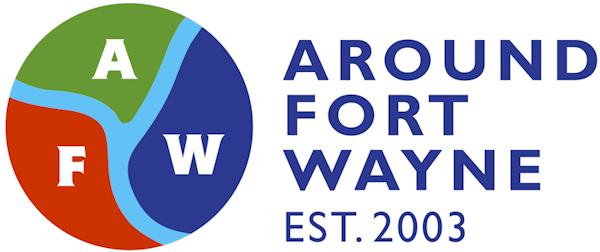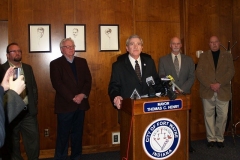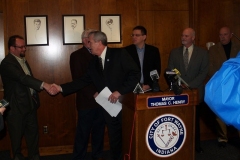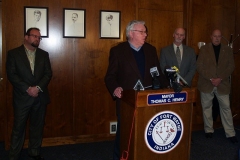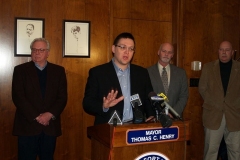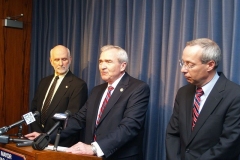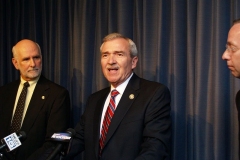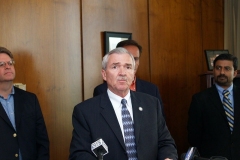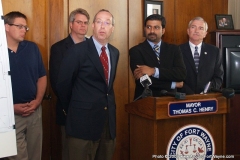![]()
News release from the Northeast Indiana Passenger Rail Association (NIPRA):
Completion of passenger rail plan announced for Northern Indiana & Ohio cities
Service from Columbus through Fort Wayne and Warsaw to Chicago
Click on the link below for a pdf of the Executive Summary Document of the Northern Indiana / Ohio Passenger Rail Corridor Business Plan / Feasibility Study:
Executive Summary_Press Release_6.28.13
The Northeast Indiana Passenger Rail Association, Inc. today announced the release of a Business Plan laying the groundwork for a regional, eleven-city, passenger rail corridor between Columbus, Ohio and Chicago, Illinois through Fort Wayne and Warsaw, Indiana.
The proposed system would operate twelve trains each way per day, including at least six express schedules. With modern diesel equipment running at speeds of up to 110 miles per hour to start, the three-hundred mile trip between downtown Chicago and downtown Columbus would normally require only three hours, forty-five minutes (express service), or four hours (local service). Track and safety improvements in a potential future phase would support speeds up to 130 mph and a downtown Chicago to downtown Columbus express time of three hours, twenty minutes.
The Business Plan, which includes evaluation and modeling of service scenarios, operating strategies, fare structures, ridership and revenue forecasts, operating and capital costs, and financing and funding arrangements, was conducted by Transportation Economics & Management Systems, Inc. (TEMS) of Frederick, Maryland under contract to the Northeast Indiana Passenger Rail Association, Inc (NIPRA). TEMS has previously conducted the economic analysis for the nine-state Midwestern Regional Rail Initiative (2007) and for the Ohio and Lake Erie Regional Rail “Ohio Hub” Study (2007) for the states of Ohio, Pennsylvania, Indiana, Michigan, and New York.
Fred Lanahan, President of the Northeast Indiana Passenger Rail Association, noted that his organization is pleased that financial analysis indicates a significant surplus of benefits from the project in terms of service revenues, user benefits (including time savings), employment impacts, and reductions in congestion and emissions. Over the thirty-year life of the project, the project produces benefits of over $6 billion, with a positive benefit/cost ratio of 1.7 ($1.70 in direct benefits for each dollar invested). The analysis also indicates that private operation of the system would be possible without annual government subsidies.
Regional economic benefits over the life of the project are projected to include creation of 26,800 new full time equivalent jobs; $700 million per year in additional household income; and $2.6 billion in joint development opportunities for the corridor communities.
Over 2 million riders per year on the Columbus-Chicago rail corridor are projected after a 12- to 24-month start-up period. At the end of 2012, the Midwest Interstate Passenger Rail Commission reported that ridership on Amtrak “corridor” service within the Midwest once again experienced record growth during fiscal year 2012. Total ridership on the nine routes grew by 3.5 percent over the previous year; during the past five years, corridor service ridership in the Midwest has risen 35 percent.
Currently, the 1.9 million Columbus metropolitan area population is the largest in the U.S. that is not served by any type of passenger rail. Fort Wayne, located midway between Columbus and Chicago, represents the largest city in Indiana without any form of passenger rail service. Columbus is the 15th-largest U.S. city and Chicago is the third-largest.
Geoff Paddock, a Fort Wayne City Councilman and a founding member of the NIPRA Board of Directors, noted “The economic impact for Indiana is substantial. We could see thousands of new jobs for Hoosiers in the northern third of our state, and hundreds added here in Fort Wayne,” he said. “The addition of passenger rail is a critical transportation link to the east and west. Train service would also encourage more tourism in this area of the state, make development in the downtown area more attractive for investors, and give an opportunity to get more people from the train station to the Fort Wayne International Airport, by way of Citilink bus service,” he added.
Chicago, with its MSA population of 9.5 million, is the economic and transportation hub of the $2.8 trillion regional economy (including the nine states of the Midwestern Regional Rail Initiative: Illinois, Indiana, Iowa, Michigan, Minnesota, Missouri, Nebraska, Ohio and Wisconsin). A half million jobs lie within a two-mile radius of Chicago’s Union Station, the western terminus of the rail corridor project.
Fort Wayne Mayor Tom Henry noted, “The Business Plan for the Chicago – Columbus corridor shows that the time is right for investing in our community and in our State. Cities throughout the Midwest are seeking better business connections to and from Chicago, and with each other. Our cooperation as cities located on this strategic interstate corridor, will allow us to share in the significant economic benefits of daily high-speed rail travel.”
Mayor Henry thanked fellow elected officials Lima Mayor David Berger; Columbus Mayor Michael Coleman; Warsaw Mayor Joseph Thallemer; New Haven Mayor Terry McDonald; and Allen County Indiana Commissioners Linda Bloom, Therese Brown, and Nelson Peters for their support in funding the completion of the feasibility study/business plan for the 300-mile corridor. Other groups supporting the funding of the Feasibility Study/Business Plan included the Lima Community Foundation; the Orthopedics Capital Foundation, Inc. (Warsaw, Indiana); the Warsaw Kosciusko County Convention and Visitors Bureau; the Warsaw / Kosciusko County Chamber of Commerce; Steel Dynamics, Inc.; the Community Foundation of Greater Fort Wayne; and Indiana Michigan Power.
The proposed next step for the development of the rail corridor is a “Tier One” Environmental Impact Study for which the corridor cities are now identifying funding.
